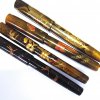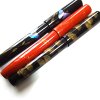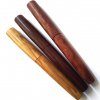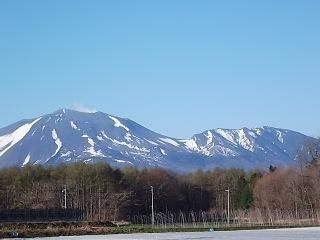Artisan Japanese urushi lacquer, or urushinuri in Japanese, has several notable lacquer ware techniques. Urushinuri yield a waterproof finish.
Our friend, Mr. Osamu NEGISHI from Kiso, Nagano--also famous for its kiso urushinuri--applies the aka-tamenuri,Negoronuri, kiji-tame and nuri techniques as well as Honshu,Kinpaku to our pens.
*Aka-tamenuri ( aka meaning ‘red’ ) renders a smooth, red gloss.
*Tamenuri (technique consisting in covering a layer of coloured urushi with a coating of clear urushi)
*Negoronuri ( red urushi or green urushi with a black-urushi undercoat )
*Kiji-tame ( kiji meaning ’grain of wood’ ) renders a transparent effect on the wooden barrel.
*Iro urushi (colored urushi)
The fuki-urushi ( fuki meaning ‘wipe off’ ) technique renders a clear finish so that the grain of the wood is enjoyed. Motoshi completes the fuki-urushi work himself. Interestingly, after the clear urushi is applied and wiped away immidediately, it must dry in a moist setting, and Motoshi repeats this cycle more than 10 times for each pen.
Urushi Artisans in Wajima
Maki-e / Chinkin / Raden-Rankaku
Maki-e shi ( artisans ) and Urushi nuri shi (urushi artisans) in Wajima appliy maki-e, chinkin, raden-rankaku on our pens. Their techniques of taka maki-e and togidashi maki-e also make beautiful and unique designs as well as chinkin. These are intricate and detailed techniques that yield beautiful results.
*chinkin ( gilded hair-line engraving ) clear urushi finish
*raden (mother-of-pearl) inlay
*rankaku (eggshell decoration)
*Togidashi maki-e (maki-e technique with polished sprinkled circle gold powder design)
Urushi Pens
Saiun nuri by Chiba Urushi Art Studio
Chiba Urushi Art Studio applies Saiun-nuri to our pens. The Saiun nuri fountain pen appears for the first time in Japan.
How to make Saiun nuri
2. Apply urushi on it and sperinkle tin powder before the urushi dries.
3. Apply iro-urushi ( colored urushi ) several times on it to make the surface smooth.
4. Polish the surface until the tin beneath is revealed to the surface.
It is important how the tin appears.
5. Rub urushi thinly until the surface gets shiny.














